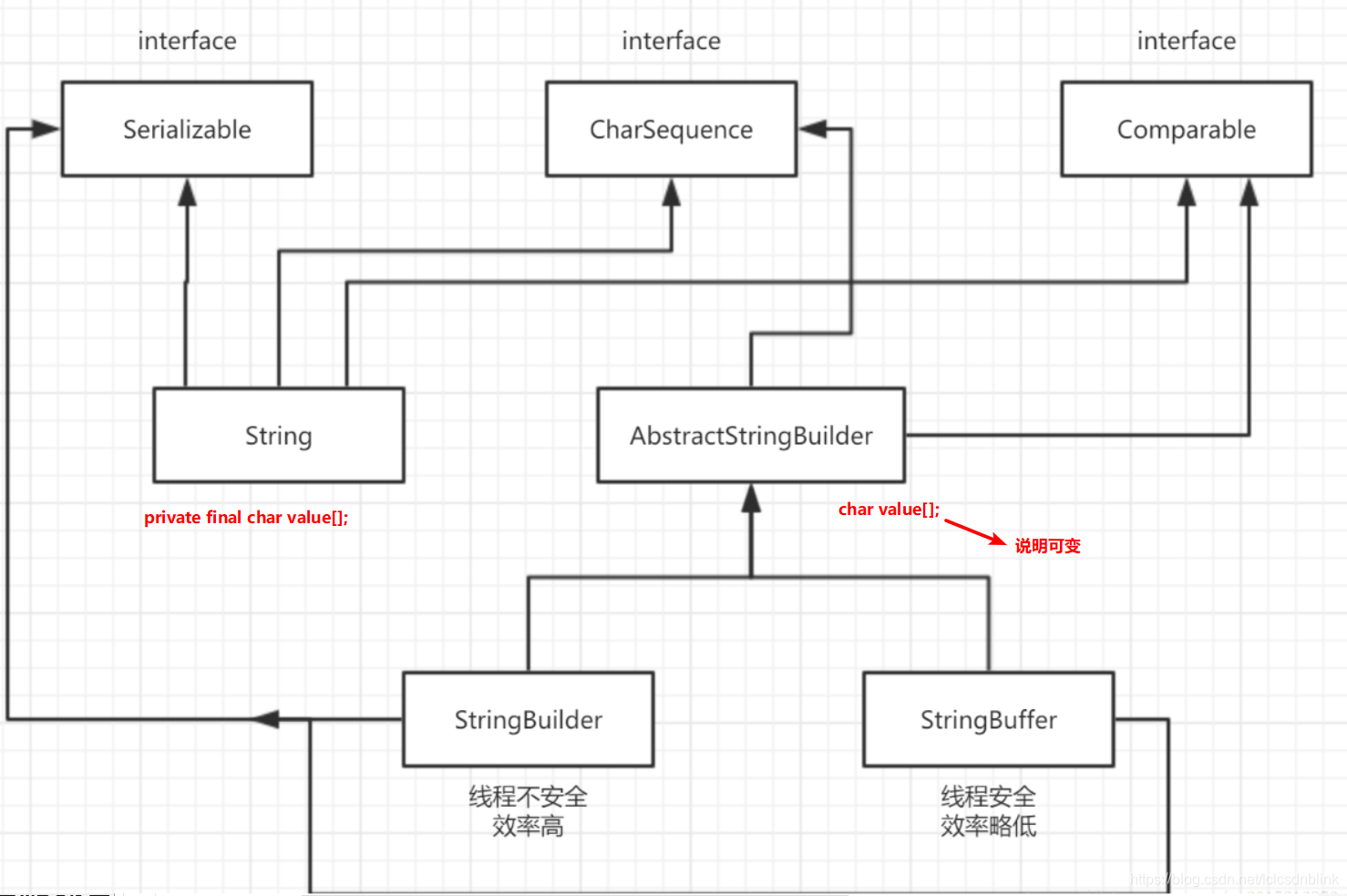JAVA---StringBuffer、StringBuilder、String
本文共 1457 字,大约阅读时间需要 4 分钟。
目录
String+号
字符串串联符号(“+”)以及将其他对象转换为字符串的特殊支持。字符串串联是通过StringBuilder(或StringBuffer)类及其append方法实现的,该方法由Object类定义,并可被Java中的所有类继承。
StringBuffer
- 是字符串缓冲区,是一个容器
- 而且长度是可变化的
- 可以字节操作多个数据类型
- 是一个可变字符序列,有一个初始容量capacity,可以手动设置,JDK1.8中默认初始容量为16,当字符串的大小大于原容量时,容量等于字符串长度+16
1.存储
StringBuffer append(); //将指定数据作为参数添加到已有数据结尾处StringBuffer insert(index,数据);可以将数据插入到指定index位置
2.删除
StringBuffer delete(start,end); //删除缓冲区中的数据,包含start,不包含endStringBuffer deleteCharAt(index); //删除指定位置的字符
3.获取
char charAt(int index);int indexOf(String str);int lastIndexOf(String str)int length()String substring(int start,int end)
4.修改
StringBuffer replace(start,end,string);void setCharAt(int index,char ch);
5.反转
StringBuffer reverse();
6.将缓冲区中指定数据存储到指定字符数组中
void getChars(int strBegin,int srcEnd,char[] dst,int dstBegin)
StringBuffer
支持和StringBuilder所有相同的操作,不同的是StringBuffer是线程安全的,在声明的方法中使用synchronized关键字进行修饰,因此单线程中一般要比StringBuilder效率低
StringBuffer是线程同步
StringBuilder是线程不同步,建议使用
升级三个因素:
1.提高效率
2.简化书写
3.提高安全性

String、StringBuffer 、 StringBuilder联系
- 当对字符串进行修改的时候,需要使用 StringBuffer 和 StringBuilder 类。
- string对象是不可变的,StringBuffer 和 StringBuilder 对象都是可变的。
- 和 String 类不同的是,StringBuffer 和 StringBuilder 类的对象能够被多次的修改,并且不产生新的未使用对象。
- StringBuilder 类在 Java 5 中被提出,它和 StringBuffer 之间的最大不同在于 StringBuilder 的方法不是线程安全的(不能同步访问)。
- 由于 StringBuilder 相较于 StringBuffer 有速度优势,所以多数情况下建议使用 StringBuilder 类。然而在应用程序要求线程安全的情况下,则必须使用 StringBuffer 类。
- String和StringBuffer他们都可以存储和操作字符串,即包含多个字符的字符串数据。而StringBuffer是字符串变量,它的对象是可以扩充和修改的。
转载地址:http://ymtf.baihongyu.com/
你可能感兴趣的文章
nmap使用
查看>>
Nmap扫描教程之Nmap基础知识
查看>>
nmap指纹识别要点以及又快又准之方法
查看>>
Nmap渗透测试指南之指纹识别与探测、伺机而动
查看>>
Nmap端口扫描工具Windows安装和命令大全(非常详细)零基础入门到精通,收藏这篇就够了
查看>>
NMAP网络扫描工具的安装与使用
查看>>
NMF(非负矩阵分解)
查看>>
nmon_x86_64_centos7工具如何使用
查看>>
NN&DL4.1 Deep L-layer neural network简介
查看>>
NN&DL4.3 Getting your matrix dimensions right
查看>>
NN&DL4.7 Parameters vs Hyperparameters
查看>>
NN&DL4.8 What does this have to do with the brain?
查看>>
nnU-Net 终极指南
查看>>
No 'Access-Control-Allow-Origin' header is present on the requested resource.
查看>>
No 'Access-Control-Allow-Origin' header is present on the requested resource.
查看>>
NO 157 去掉禅道访问地址中的zentao
查看>>
no available service ‘default‘ found, please make sure registry config corre seata
查看>>
No compiler is provided in this environment. Perhaps you are running on a JRE rather than a JDK?
查看>>
no connection could be made because the target machine actively refused it.问题解决
查看>>
No Datastore Session bound to thread, and configuration does not allow creation of non-transactional
查看>>